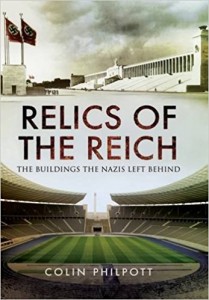Philpott, Colin. Relics of the Reich: The Buildings the Nazis Left Behind.
Barnsley, Pen & Sword Books, 2016.
 New this week at the Library is Colin Philpott’s 2016 book Relics of the Reich: The Buildings the Nazis Left Behind, a fascinating analysis of Nazi architecture, examining “the physical legacy of the Nazis, their buildings, their structures, and their public spaces” (Pg. x). The Nazis were strategists, everything carefully calculated to serve their ambitions and hopes of a master race, and this included their buildings, everything from the Reichstag to Berchtesgaden to Dachau Concentration Camp. Philpott’s book emphasizes just how critical the physical spaces were to the Nazis’ success in maintaining power and committing genocide.
New this week at the Library is Colin Philpott’s 2016 book Relics of the Reich: The Buildings the Nazis Left Behind, a fascinating analysis of Nazi architecture, examining “the physical legacy of the Nazis, their buildings, their structures, and their public spaces” (Pg. x). The Nazis were strategists, everything carefully calculated to serve their ambitions and hopes of a master race, and this included their buildings, everything from the Reichstag to Berchtesgaden to Dachau Concentration Camp. Philpott’s book emphasizes just how critical the physical spaces were to the Nazis’ success in maintaining power and committing genocide.
Philpott explores themes in Nazi architecture, including what he calls “establishing the faith,” “enforcement,” “showing off to the world,” “future fantasies,” and “downfall.” Within each theme he discusses specific buildings that served that purpose. For example, “showing off to the world” focuses primarily on the 1936 Olympics, the 1937 World’s Fair, and other locations international visitors passed through, such as airports. Similarly, “future fantasies” discusses the future plans of the Nazis that never came to be due to the escalation of World War II, including a vast plan to forever alter Berlin and rename it “Germania.” Hitler planned “for Germania as Welthaupstadt (World Capital) of a trimphant Germany…[to represent German] world domination” (Pg. 113). Philpott describes the plans as being so grand and megalomaniacal as to be absurd. Through these plans, it becomes clear that Hitler had become consumed by his desire for power, and so confident in his control over Germany and ability to dominate other countries by 1939, that these self-aggrandizing plans to essentially renovate the whole of Berlin seemed realistic and inevitable. But of particular interest is Philpott’s theme on “Holocaust.” Not only does Philpott highlight the physical spaces of the Holocaust, but he also discusses the ways those spaces and the horrors which took place there have been commemorated. Philpott points out that some of these memorials were self-serving, especially those built while Germany was split between the Allied powers; the Russians sought to paint Communism as a liberating force that freed victims from Nazi rule, while the American side of Germany produced monuments after facing pressure from survivors to do so.
Countless books have been written on the Third Reich, the genocide it perpetrated, and the lasting impact of a regime that committed unmatched horrors. There is a tendency to focus on the terrors of the Holocaust, and rightly so, but to better understand the Holocaust, one must also seek to understand other aspects of what the Nazis sought to achieve. Adolf Hitler and his colleagues hoped to build a master race, eliminating Jews, gypsies, homosexuals, and the mentally disabled in order to build the Aryan society of which they dreamed. Thus, the systematic murder of six million people became a priority for the Nazi regime. But the development of this master race also included building, as well as destruction and murder. It required the building of concentration camps to house the people they planned to murder, the construction of ghettos before Jews were forced into train cars like cattle, they had to build the gas chambers and the crematoriums, and there had to be new government buildings to symbolize the new era. This physical, architectural element was crucial to the Third Reich’s plans for their “Final Solution” and the world they tried (and failed) to build. Everything they did, everything they built was coldly calculated to serve those interests.
The systematic murder of six million people is an atrocity that remains somewhat incomprehensible. For all the books, the studies, and the conversations, there is something about understanding the Holocaust that remains elusive because of the sheer scope of it. The questions that keep recurring involve the unanswerable: why? Why did Hitler and the Reich murder millions of people? Why did so many Germans do and say nothing? We have some answers to these questions, but they will never be complete, and they will never be enough to make up for the six million lives taken. But by examining what the Nazis built, and the careful planning required to carry out their Final Solution, Philpott’s Relics of the Reich provides more answers – and more questions. The Holocaust, if possible, becomes worse in a way because of the cruelty and coldness evident in the planning of the gas chambers, crematoriums, and concentration camps, as well as the callous and narcissistic ways in which the Third Reich planned Germany’s future as it carried out mass murder. And so, we have more “whys.” Why did the Nazis feel so little empathy and so little respect for human lives (those who did not fit their vision of the Aryan race) that they felt compelled and justified in committing genocide? Why did no one speak out when the crematoriums were built, especially when locals could smell the burning bodies? Why would they plan to renovate the whole of Berlin while millions were dying in the gas chambers? You can ask “why” over and over and over again. There will never be an answer, at least not a satisfactory one, but the answer is nonetheless worth the seeking. And, perhaps surprisingly, the physical spaces built by the Nazis play an important role in discovering answers to the mysterious, tragic “whys” of the Holocaust.
